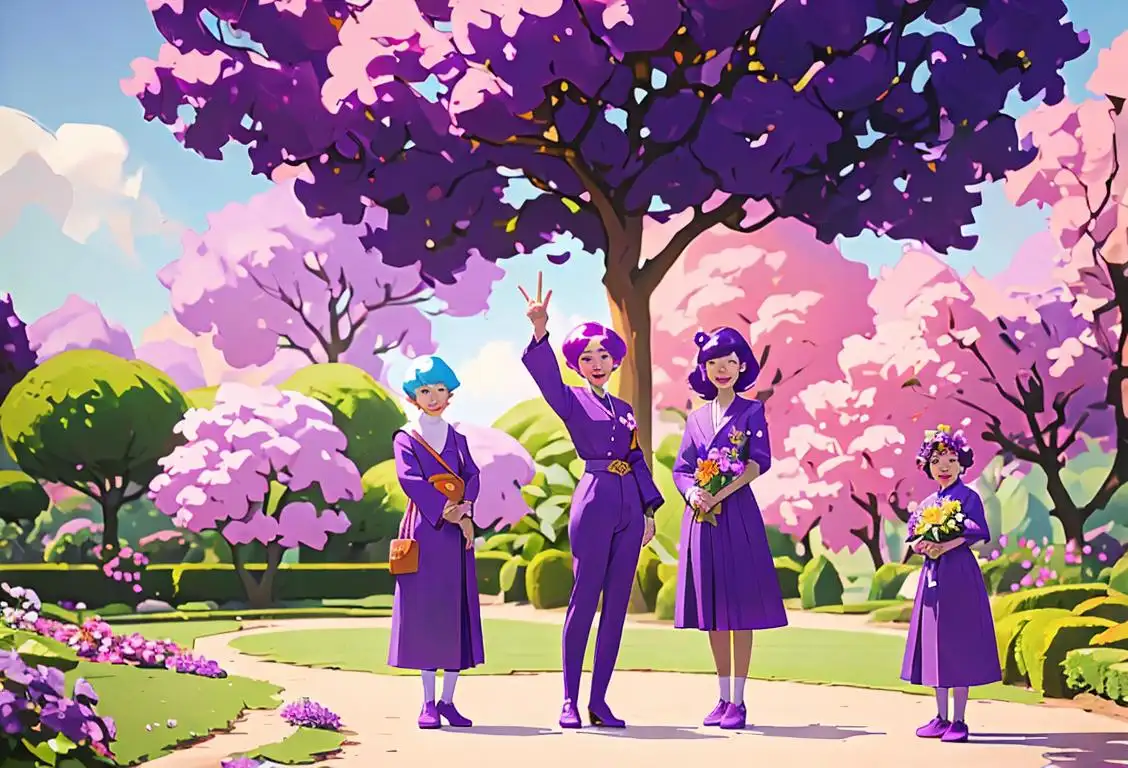National Wear Purple For Peace Day

Welcome to the wonderful world of National Wear Purple for Peace Day! If you're a fan of the color purple and spreading peace, then today is your day to shine. Whether you're wearing a regal purple dress, painting your nails a stunning shade of lavender, or showcasing your purple socks, this is the perfect opportunity to show your support for peace in a colorful and fashionable way.
When is Wear Purple For Peace Day?
It's national wear purple for peace day on the 16th May.
The Purple Path to Peace
On this special day, people from all walks of life come together to raise awareness and promote peace. The origins of National Wear Purple for Peace Day are shrouded in mystery, but it is believed to have gained popularity online, with various social media platforms playing a key role. Purple has long been associated with peace and spirituality, making it the ideal color to rally behind.
Why purple, you may ask? Well, purple combines the tranquility of blue and the energy of red, creating a beautiful synergy that represents peace, calmness, and harmony. It's a color that transcends cultural boundaries and speaks to our shared desire for a more peaceful world.
How to Celebrate in Style
So, how can you participate in National Wear Purple for Peace Day? Fear not, we have some delightful suggestions to help you on your purple-filled quest for peace:
- Dress to Impress: Don your favorite purple attire and let your inner peace warrior shine. Whether it's a purple t-shirt, a flowing lavender dress, or even purple accessories, let purple be your guiding color.
- Purple Picnic: Gather your loved ones and pack a purple-themed picnic. From purple grapes and eggplants to lavender lemonade, let purple be the palette for your culinary creations.
- Sport Purple with Pride: Join a local sports event and show your support for peace by donning purple gear. You'll make a vibrant statement and inspire others to follow in your footsteps.
- Spread the Purple Love: Share your purple-clad photos on social media, using the hashtag #WearPurpleForPeace. Not only will you connect with like-minded individuals, but you'll also help raise awareness for this mindful cause.
- Be a Purple Philanthropist: Make a donation to a peace-promoting organization or participate in a local peace initiative. Your support will make a difference and contribute to a brighter, more harmonious future.
Did You Know?
In Hinduism, purple is associated with spirituality and wisdom. It is often used during religious ceremonies and signifies the connection between the earthly and divine realms.
History behind the term 'Wear Purple For Peace'
1960
The Birth of the Peace Symbol
The peace symbol, a design that combines the semaphore letters 'N' and 'D' for nuclear disarmament within a circle, was created in 1958 by British artist Gerald Holtom. However, it wasn't until the 1960s that it gained widespread recognition as a symbol of peace and nonviolence. The simplicity of the design and its powerful message resonated with the counterculture movement of the time, becoming a prominent symbol of the peace movement.
1969
The Vietnam War Protests
During the late 1960s, the United States was embroiled in the Vietnam War. The conflict caused deep divisions among Americans, with a growing number of people advocating for peace and an end to the war. The anti-war movement gained momentum, and purple, often associated with peace, love, and spirituality, emerged as a symbolic color used by protesters. Wearing purple became a way for individuals to express their opposition to the war and their desire for peace.
1985
Purple Ribbon Campaign
In 1985, the Purple Ribbon Campaign was launched to raise awareness about peace and nonviolence. The campaign aimed to promote dialogue, conflict resolution, and peaceful approaches to resolving conflicts. The purple ribbon served as a visual representation of the campaign's message, encouraging individuals to actively work towards peace in their communities and the world at large.
2001
Purple Fridays
Following the tragic events of September 11, 2001, a grassroots movement known as Purple Fridays emerged as a way to honor and support the military and promote peace. People started wearing purple every Friday to show solidarity with military families and veterans, as well as to advocate for peaceful resolutions instead of war. The movement spread across communities, workplaces, and schools, emphasizing the importance of peace and unity in times of conflict.
2010
Wear Purple for Peace Day
Wear Purple for Peace Day is a national observance held on October 20th each year. The day encourages people to wear purple as a symbol of their commitment to peace, nonviolence, and conflict resolution. It serves as a reminder of the power of individual actions to promote peace in their own lives and communities. The observance aims to raise awareness about the importance of peaceful resolutions and to inspire people to actively work towards a more peaceful and inclusive world.
Did you know?
In Hinduism, purple is associated with spirituality and wisdom. It is often used during religious ceremonies and signifies the connection between the earthly and divine realms.Tagged
awareness food fun loved ones sportsFirst identified
16th May 2015Most mentioned on
16th May 2017Total mentions
36Other days
One Day
Action Day
Opposite Day
Happiness Day
Suicide Prevention Month Day
Bowling Day
Foundation Day
Drink A Beer Day
Trivia Day
Awareness Day









